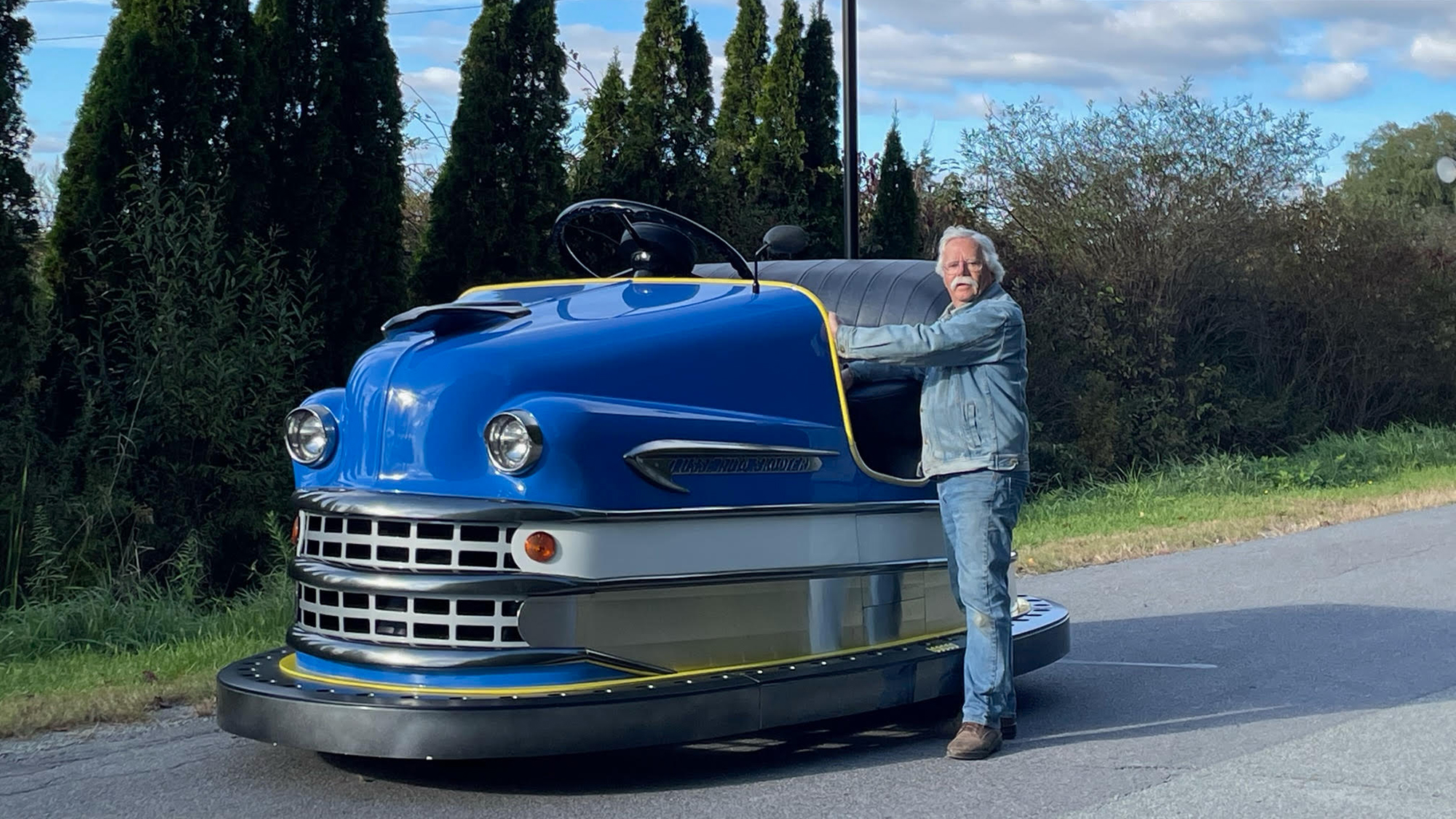

“I always build things,” says Dan Hryhorcoff.
Case in point: Hryhorcoff has constructed an absolutely delightful giant bumper car, a project that he says began during the pandemic. The rest of us may have baked bread as COVID came down the pike, but Hryhorcoff, who lives in northeastern Pennsylvania and has also built a submarine, constructed an enormous blue bumper car. It gets its propulsion from a repurposed Chevrolet engine and is street-legal.
Before he constructed the big bumper car, Hryhorcoff had made a different vehicle, starting on it around 2013 or so. “When I retired, I decided I kind of wanted to build a car,” he recalls. For that project, he chose to focus on a 1950s pedal car for children called a Murray “sad face.” “I decided to copy that and make a large one.” (Those Murray models have a front that does indeed look like a sad face, but anyone who sees Hryhorcoff’s work will probably smile.)
Creating that big red vehicle provided him with further experience working with fiberglass, a material he had also worked with when building the submarine. “I had a lot of fun with that [Murray car] at car shows and things, and it got a lot of attention from a broad audience,” he says.
“Then COVID hit,” he adds. He wanted a new project. His thinking? “Another car project would be good.”
Building the big bumper car
He settled on a bumper car. To get the source material he needed for the project, he turned to an amusement park in Elysburg, Pennsylvania called Knoebels, and the bumper cars they have there. Specifically, he focused on the 1953-model bumper car that was made by a company called Lusse. He liked that it had a “Chevrolet pickup truck sorta look” from the 1950s.
“I decided to copy one of those,” he says. Spending some eight hours at Knoebels gave him the chance to get the information he needed. “I measured, and took photos, and made templates, and whatever I needed to, to copy the car as well as I can.” He chose to make his version of the car double the size of the base model. As the Scranton Times-Tribune noted in a story about Hryhorcoff in July, the bumper car ride at Knoebels dates back to the immediate post-World-War-II era.
[Related: This Florida teen is making a business out of rebuilding old-school auto tech]
Inside, the big bumper car’s power plant comes from a Chevrolet Aveo. “I took the front of the Aveo, and chopped it off, and put that in the back of the bumper car,” he explains. “And the front of the bumper car is a motorcycle wheel.” That single wheel up front means it can turn very sharply. The exterior is made out of fiberglass. All told, it measures 13 feet long, 7 feet wide, and 5.5 feet tall, making it twice the size of a regular bumper car. A pole in the back mimics the way actual bumper cars get their electricity, except this one connects to nothing.
A project like this would likely be a bumpy ride for anyone without the experience that Hryhorcoff, 72, brings to the table. “I learned to run a lathe when I was 13 years old, with my dad, and he was kind of a jack-of-all-trades,” he recalls. (A lathe is a tool for forming metal into a round shape, and a wood lathe is the kind of equipment you could use to make a baseball bat.) He built a go-cart, tinkered with lawn mowers, and learned about auto repair in a garage. His interest, as he describes it, was “all around mechanical.”
He spent four years after high school in the Navy in the early 1970s, where he worked stateside and repaired radios for F-4 jets, and then studied mechanical engineering at Penn State. After working for a drilling company, he started his own machine shop called Justus Machine.

Always diving into something new
The submarine he built came from plans for a K350 model purchased from George Kittredge, and is called Persistence. “I knew I was building something that wasn’t gonna kill me, if I build it correctly,” he says. (Watch a video of the sub in action here.) That sub has gone as deep as 540 feet with no one on board, Hryhorcoff says, and he’s taken it down himself to about 150 feet deep.
[Related: How does a jet engine work? By running hot enough to melt its own innards.]
Hryhorcoff describes himself as an engineer, not an artist, and prefers to follow plans and undertake projects in which he knows any challenges he might face are surmountable. “Any project I’ve ever chose was a project that I knew I can get through it, but I had something new to learn in the process,” he says. “There were always some unknowns.” But those unknowns, he adds, were within the realm of doable for him and his equipment, even if he had to learn new stuff along the way.
“I’d rather big projects, rather than a dozen little ones,” he adds.
Watch a short video about Hryhorcoff and this project, below:

